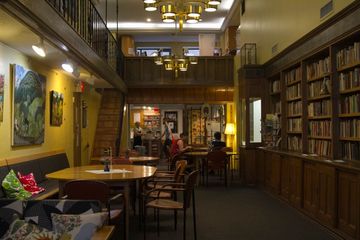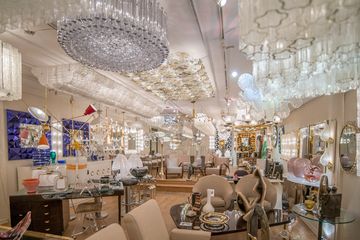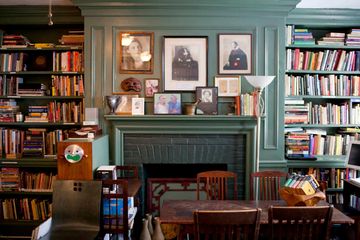Although filled to the brim inside, the adventure begins simply by gazing through the impressive windows of John Salibello's three antique lighting shops on East 60th. The dazzling chandeliers hanging from the ceiling at No. 211 were only the beginning, for upon entering, I learned that the excitement extends back into an even more inspiring gilded maze where every inch of space is utilized to display the carefully curated collection, both upstairs and down a flight. Lori Gray, the store's manager, spoke to me about John Salibello's origins. It turns out that she is one of the best people to do so, as she has been by John's side for years - ever since he was working in the fashion industry. Lori followed John when he left Benetton, as he had become a close friend and she "deeply respected his taste. " I learned from Lori that John was one of the first people to deal in Mid-Century Modern design, "probably because he opened his business just as it was becoming temporarily distant enough to be desirable. " Breaking new ground, he found his stride and has stayed true to it ever since. John's knowledge of the period is extensive, but he makes a point of not being driven by a particular designer, despite their fame. As Lori explained, "He can "talk that talk, " but in the end, John travels the world searching for beautiful pieces, no matter what their origin. "This is why he has been so successful as a trend-setter, " Lori proudly stated. Most items are vintage, but there are some custom-made objects, such as a row or colorful glass boxes made by an artist from Murano. The employees chimed in during a conversation one day, sharing with me how they enjoyed having input into the color combinations for each one. The staff is a crucial part of this well-oiled machine. As one woman put it, they are in charge of the "visualization of the store - John does the buying and we set it up and then sell it. " They are also meticulous about maintaining the inventory, as every piece is always gleaming, a hard outcome to achieve in a store filled with so much glass. John Salibello's triumph in the furniture world also has a lot to do with its location. Because the store is in the design district, everything is in one place, making it easy for interior designers and their clients. When engaging in conversation with John, himself, one day, he expanded on his concept of three boutiques on one street. "We have a tremendous amount of inventory, as that is what our customers prefer. " He said that he loves 60th, but because he cannot house everything in one location, he has chosen to take over additional retail space, while remaining in the same neighborhood. John explained that just the shear size of the pieces he finds requires more room, and then went on to say that he is pleased that his shops are in demand, as people like what he carries and he is forever finding new things to add. As John expressed, "if you want to be spectacular, this is the only way to do it. "





